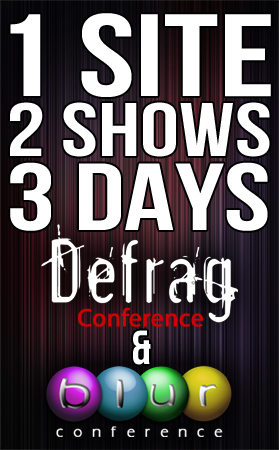As we head into Defrag year 5, I’ve been spending some time looking back on what we’ve talked about over the previous years. Defrag, like the tech industry in general, has really grown over the past five years.
Defrag began by looking at “information overload” in its largest sense. As such, we covered everything from the semantic web to implicit web tools to what was then the nascent “social” (e2.0) niche industry. The first year of Defrag (2007) may have actually addressed more “big data” topics than anything else. By years two and three of Defrag, we had focused pretty firmly on the “e2.0″ space, but we were also pushing hard on making the folks in that space see the other side of the coin — namely, social media and marketing. We found ourselves talking about “crazy” ideas like app stores for internal employees, “social” software that combined the collaborative functionality of e2.0 tools with the external, communicative service-facing functionality of social media tools. In short, we were ahead of the curve, but still anchored to a software movement pretty firmly anchored in “e2.0.”
By year 4, something had changed. I had consciously decided to “un-anchor” the show from the e2.0 movement at the end of year 3 — not because I don’t believe in what’s happening there (I do), or don’t love the vendors (I do). I did so because I know what happens to topically-driven shows over time. They die. It’s unavoidable. And Defrag had such a loyal and driven community at this point, that I knew “death” was not an option.
In truth, after year 3, the Defrag community was making one thing very clear: we want to be surprised by the ideas on stage. Sure, we want to hear about “social” stuff, but more than that, bring “what’s over the horizon” to the stage. So, year four of Defrag began to “float” a bit more. We still addressed “social,” but now we also talked big data and mobile and APIs and cloud a bit more. As it turns out, Defrag was shaping itself around what I think are the key drivers in a wide-ranging change occurring in enterprise software.
As I see it, there are four components to a large wave sweeping across the enterprise: social, mobile, cloud, and big data. “Social” is the well-known collaborative, emergent tools. “Mobile” is the obvious device driven (tablet and phone) revolution. “Cloud” refers to the *radical* change in how IT is architecting it’s resources and development assets (this includes APIs). And “big data” is the movement that is allowing for a new level of intelligence to be derived from data sources that are quite often NOT internal to an enterprise.
All of these four factors are about a radical decentralization of IT in the enterprise:
1. “Social” is the decentralization of work processes (yea, that’s put really badly, but you know what I mean).
2. “Mobile” is the decentralization of the physical barriers of the enterprise. This also includes the breakdown of the IT metaphors around “firewalls.” The perimeter is now non-existent.
3. “Cloud” is the decentralization of how IT assets, resources and development are derived, used, and managed.
4. “Big data” is the decentralization of where the intelligence that the business is generating comes from. The distributed processing power of big data apps and DBs now makes it possible to take in and process intelligence from data sources NOT “scrubbed” by being inside of the enterprise perimeter.
I don’t know that any one of these four factors is “driving” the decentralization of the enterprise. I suspect that it’s more that certain demographic and geographic realities (and economic) are driving it, and these factors are emergent in the face of what’s possible.
As I look at the “un-anchored” Defrag conversation in year 5, those four factors form the organizing “story” for me. I think you can see it reflected in the agenda. And I hope you’ll join us.

